Effects of Homogenization Heat Treatment on the Fe Micro-Segregation in Ti-1023 Titanium Alloy
Abstract
:1. Introduction
2. Materials and Methods
2.1. Sampling and Corrosion of Ti-1023 Ingots
2.2. Detection of Fe Element Content Distribution in Sample Grains
2.3. Homogenization HT of Sample
3. Numerical Simulation of Fe Diffusion Intragranular of Ti-1023 during Homogenization HT
- Grain boundary and dislocation have no influences on diffusion.
- The diffusion rate of Fe is equal in all directions.
- The diffusion coefficient of Fe is a constant value when the temperature and composition are determined.
4. Results and Discussion
4.1. Characterization of Intragranular Fe Content Distribution of Ti-1023 Ingot
4.2. Effect of Homogenization HT on the Distribution of Fe Content in the Grains
4.3. Homogenization Factors of Fe Content in Ti-1023 Grains during HT
4.3.1. Effect of HT Temperature on Homogenization of Fe in Grains
4.3.2. Effect of HT Time on Homogenization of Fe in Grain
5. Conclusions
- The Fe content in the Ti-1023 ingots near the grain boundary is higher than that in the core of the grain.
- The degree of uniform distribution of Fe content within the grain can be improved by homogenization HT. As the HT temperature increases, the Fe element migration capacity improves and the degree of uniform distribution of Fe elements increases.
- Homogenization HT time has a great influence on the distribution of Fe content within the grain. The longer the HT time, the more uniform the distribution of Fe content. Fe content can achieve complete uniformity within the grain of Ti-1023 after homogenization HT at 1200 °C for 12 h.
- Homogenization HT of Ti-1023 at 1150 °C to 1200 °C for 12 h can reduce the Fe content deviation from about 10% to less than 4%.
Author Contributions
Funding
Institutional Review Board Statement
Informed Consent Statement
Data Availability Statement
Conflicts of Interest
References
- Neelakantan, S.; San Martin, D.; Rivera-Diaz-del-Castillo, P.; van der Zwaag, S. Plasticity Induced Transformation in a Metastable Beta Ti-1023 Alloy by Controlled Heat Treatments. Mater. Sci. Technol. 2009, 25, 1351–1358. [Google Scholar] [CrossRef] [Green Version]
- Wang, Q.; Yang, C.; Wu, J.; Gao, B.; He, Z.; Wang, K. Phase Transformation Behavior of Ti-1023 Under Static Heat Treatment and Dynamic Thermo-Mechanical Coupling. Mater. Charact. 2022, 192, 112248. [Google Scholar] [CrossRef]
- Yang, H.; Chen, Z.; Zhou, Z. Influence of Cutting Speed and Tool Wear On the Surface Integrity of the Titanium Alloy Ti-1023 During Milling. Int. J. Adv. Manuf. Technol. 2015, 78, 1113–1126. [Google Scholar]
- Lhadi, S.; Purushottam raj purohit, R.r.p.; Richeton, T.; Gey, N.; Berbenni, S.; Perroud, O.; Germain, L. Elasto-Viscoplastic Tensile Behavior of as-Forged Ti-1023 Alloy: Experiments and Micromechanical Modeling. Mater. Sci. Eng. A 2020, 787, 139491. [Google Scholar] [CrossRef]
- Li, L.; Wang, Z.; Ma, W. Experimental Study on the High Temperature Impact Torsional Behavior of Ti-1023 Alloy. Materials 2022, 15, 3847. [Google Scholar] [CrossRef]
- Li, P.; Sun, X.; Zhang, T.; Zhang, H.; Wang, D.; Sun, Q.; Xiao, L.; Sun, J. Adaptive Volume Control in Titanium Alloy for High Temperature Performance. Materials 2019, 12, 3950. [Google Scholar] [CrossRef] [PubMed] [Green Version]
- Quan, F.; Chen, Z.; Zhu, Y.; Zhang, Y. A Method of Assessing the Strength of Metal Surface Using Film Samples On Titanium Alloy Ti-1023. Strain 2019, 55, e12317. [Google Scholar] [CrossRef]
- Storchak, M.; Zakiev, I.; Träris, L. Mechanical Properties of Subsurface Layers in the Machining of the Titanium Alloy Ti10V2Fe3Al. J. Mech. Sci. Technol. 2018, 32, 315–322. [Google Scholar] [CrossRef]
- Bermingham, M.J.; McDonald, S.D.; StJohn, D.H.; Dargusch, M.S. Segregation and Grain Refinement in Cast Titanium Alloys. J. Mater. Res. 2009, 24, 1529–1535. [Google Scholar] [CrossRef]
- Joseph, S.; Kontis, P.; Chang, Y.; Shi, Y.; Raabe, D.; Gault, B.; Dye, D. A Cracking Oxygen Story: A New View of Stress Corrosion Cracking in Titanium Alloys. Acta Mater. 2022, 227, 117687. [Google Scholar] [CrossRef]
- Ng, C.H.; Bermingham, M.J.; Dargusch, M.S. Eliminating Segregation Defects During Additive Manufacturing of High Strength Beta-Titanium Alloys. Addit. Manuf. 2021, 39, 101855. [Google Scholar]
- Ng, C.H.; Bermingham, M.J.; Yuan, L.; Dargusch, M.S. Towards Beta-Fleck Defect Free Additively Manufactured Titanium Alloys by Promoting the Columnar to Equiaxed Transition and Grain Refinement. Acta Mater. 2022, 224, 117511. [Google Scholar] [CrossRef]
- Fan, K.; Wu, L.C.; Li, J.J.; Wang, J.C. Numerical Simulation of Macrosegregation Caused by Buoyancy Driven Flow During Var Process for Titanium Alloys. Rare Metal Mat. Eng. 2020, 49, 871–877. [Google Scholar]
- He, Y.; Hu, R.; Luo, W.; Sun, F.; Wang, K.; Fu, B.; Li, J.; Liu, X. Effect of Stirring Magnetic Field On the Macrostructure and Macrosegregation of Fe Element of Ti-1023 Alloy Ingot. Rare Metal Mat. Eng. 2017, 46, 3063–3067. [Google Scholar]
- Liao, Q.; Ge, P.; Liu, Y.; Wang, R.Q. Fe Elemental Segregation Control of Large Sized Ti70 Alloy Ingot. Rare Metal Mat. Eng. 2020, 49, 968–972. [Google Scholar]
- Liu, X.; Feng, G.; Zhou, Y.; Fan, Q. Macrosegregation and the Underlying Mechanism in Ti-6.5Al-1.0Cr-0.5Fe-6.0Mo-3.0Sn-4.0Zr Alloy. Prog. Nat. Sci. 2019, 29, 224–230. [Google Scholar] [CrossRef]
- Yang, Z.; Kou, H.; Li, J.; Hu, R.; Chang, H.; Zhou, L. Macrosegregation Behavior of Ti-10V-2Fe-3Al Alloy During Vacuum Consumable Arc Remelting Process. J. Mater. Eng. Perform. 2011, 20, 65–70. [Google Scholar] [CrossRef]
- Gao, J.H.; Nutter, J.; Liu, X.G.; Guan, D.K.; Huang, Y.H.; Dye, D.; Rainforth, W.M. Segregation Mediated Heterogeneous Structure in a Metastable Beta Titanium Alloy with a Superior Combination of Strength and Ductility. Sci. Rep. 2018, 8, 7512. [Google Scholar] [CrossRef] [Green Version]
- Huang, S.S.; Ma, Y.J.; Zhang, S.L.; Qi, M.; Lei, J.F.; Zong, Y.P.; Yang, R. Influence of Alloying Elements Partitioning Behaviors On the Microstructure and Mechanical Properties in Alpha Plus Beta Titanium Alloy. Acta Metall. Sin. 2019, 55, 741–750. [Google Scholar]
- Prithiv, T.S.; Kloenne, Z.; Li, D.A.; Shi, R.P.; Zheng, Y.F.; Fraser, H.L.; Gault, B.; Antonov, S. Grain Boundary Segregation and its Implications Regarding the Formation of the Grain Boundary Alpha Phase in the Metastable β-Titanium Ti-5Al-5Mo-5V-3Cr Alloy. Scr. Mater. 2022, 207, 114320. [Google Scholar] [CrossRef]
- Wang, J.; Qin, Z.W.; Xiong, F.H.; Wang, S.S.; Lu, X.G.; Li, C.H. Design and Preparation of Low-Cost Alpha Plus Beta Titanium Alloy Based On Assessment of Ti-Al-Fe-Cr System. Mater. Sci. Eng. A 2018, 732, 63–69. [Google Scholar] [CrossRef]
- Xu, Z.; Wang, H.; Tang, H.; Cheng, X.; Zhu, Y. Microstructure, Microsegregation and Mechanical Properties of Directed Energy Deposited Ti-32Mo Titanium Alloy. J. Mater. Sci. 2022, 57, 12540–12555. [Google Scholar] [CrossRef]
- Zhao, Y.; Liu, J.; Zhou, L. Analysis On the Segregation of Typical Alloying Elements of Cu, Fe and Cr in Ti Alloys. Rare Metal Mat. Eng. 2005, 34, 531–538. [Google Scholar]
- Jing, Z.; Sun, Y.; Song, S. Numerical Simulation of Macrosegregation Heredity On Tc4 Titanium Alloy Ingot by Vacuum Arc Remelting. Metall. Res. Technol. 2023, 120, 116. [Google Scholar]
- Edalati, K.; Daio, T.; Lee, S.; Horita, Z.; Nishizaki, T.; Akune, T.; Nojima, T.; Sasaki, T. High Strength and Superconductivity in Nanostructured Niobium–Titanium Alloy by High-Pressure Torsion and Annealing: Significance of Elemental Decomposition and Supersaturation. Acta Mater. 2014, 80, 149–158. [Google Scholar] [CrossRef]
- Lei, Z.; Chen, Y.; Ma, S.; Zhou, H.; Liu, J.; Wang, X. Influence of Aging Heat Treatment On Microstructure and Tensile Properties of Laser Oscillating Welded Tb8 Titanium Alloy Joints. Mater. Sci. Eng. A 2020, 797, 140083. [Google Scholar] [CrossRef]
- Mitchell, A. Composition Control in Titanium Alloys. In Proceedings of the Ti-2011: 12th World Conference on Titanium, Beijing, China, 19–24 June 2011; Science Press Beijing: Beijing, China, 2012; Volume I, pp. 71–74. [Google Scholar]
- Schwaighofer, E.; Schloffer, M.; Schmoelzer, T.; Mayer, S.; Lindemann, J.; Guether, V.; Klose, J.; Clemens, H. Influence of Heat Treatments On the Microstructure of a Multi-Phase Titanium Aluminide Alloy. Pract. Metallogr. 2012, 49, 124–137. [Google Scholar] [CrossRef]
- Dichtl, C.; Zhang, Z.B.; Gardner, H.; Bagot, P.; Radecka, A.; Dye, D.; Thomas, M.; Sandala, R.; Da Fonseca, J.Q.; Preuss, M. Element Segregation and Alpha2 Formation in Primary Alpha of a Near-Alpha Ti-Alloy. Mater. Charact. 2020, 164, 110327. [Google Scholar] [CrossRef]
- Karthik, G.M.; Kim, H.S. Heterogeneous Aspects of Additive Manufactured Metallic Parts: A Review. Met. Mater. Int. 2021, 27, 1–39. [Google Scholar] [CrossRef]
- Lukyanov, A.V.; Pushin, V.G.; Kuranova, N.N.; Svirid, A.E.; Uksusnikov, A.N.; Ustyugov, Y.M.; Gunderov, D.V. Effect of the Thermomechanical Treatment On Structural and Phase Transformations in Cu–14Al–3Ni Shape Memory Alloy Subjected to High-Pressure Torsion. Phys. Met. Metallogr. 2018, 119, 374–382. [Google Scholar] [CrossRef]
- Xu, M.; Liu, G.-H.; Li, T.-R.; Wang, B.-X.; Wang, Z.-D. Microstructure Characteristics of Ti–43Al Alloy During Twin-Roll Strip Casting and Heat Treatment. Trans. Nonferrous Met. Soc. China 2019, 29, 1017–1025. [Google Scholar] [CrossRef]
- Zheng, S.; Shen, J.; Shang, Z.; Wang, W.; Xiong, Y.; Yue, X. Effects of Multi-Step Heat Treatment On the Microstructure, Segregation and Property of a Directional Solidified Ti-45.5Al–3Nb-0.11C-0.3Si Alloy Produced by Electromagnetic Confinement. Mater. Sci. Eng. A 2020, 794, 139962. [Google Scholar] [CrossRef]
- Mi, Y.; Wang, Y.; Wang, Y.; Dong, Y.; Chang, H.; Alexandrov, I.V. Effect of Heat Treatment On Microstructure and Mechanical Behavior of Ultrafine-Grained Ti-2Fe-0.1B. Materials 2023, 16, 2955. [Google Scholar] [CrossRef] [PubMed]
- Hu, M.; Wang, L.; Li, G.; Huang, Q.; Liu, Y.; He, J.; Wu, H.; Song, M. Investigations On Microstructure and Properties of Ti-Nb-Zr Medium-Entropy Alloys for Metallic Biomaterials. Intermetallics 2022, 145, 107568. [Google Scholar] [CrossRef]
- Gierlotka, W.; Lothongkum, G.; Lohwongwatana, B.; Puncreoburt, C. Atomic Mobility in Titanium Grade 5 (Ti6Al4V). J. Min. Metall. Sect. B Metall. 2019, 55, 65–77. [Google Scholar] [CrossRef] [Green Version]
- Liu, Y.; Ge, Y.; Yu, D.; Pan, T.; Zhang, L. Assessment of the diffusional mobilities in bcc Ti–V alloys. J. Alloys Compd. 2009, 470, 176–182. [Google Scholar] [CrossRef]
- Shi, R.; Luo, A.A. Applications of Calphad Modeling and Databases in Advanced Lightweight Metallic Materials. Calphad 2018, 62, 1–17. [Google Scholar] [CrossRef]
- Guo, X.; Zhou, Y.; Qi, H.; Tang, X. Study On the as-Cast Microstructure and Homogenization Mechanism of Gh3128 Superalloy. J. Mater. Eng. Perform. 2023, 1–12. [Google Scholar] [CrossRef]
- Liu, Y.; He, S.; Li, Y.; Liu, Z.; Li, C.; Li, J.; Miao, H.; Zhu, D.; Su, L. In Vitro Degradation Behavior and Microstructural Evolution of a Novel Biodegradable Zn-Mg-Sr Alloy During Homogenization. J. Mater. Eng. Perform. 2022, 32, 4283–4294. [Google Scholar] [CrossRef]
- Wang, T.; Wan, Z.P.; Li, Z.; Li, P.H.; Li, X.X.; Wei, K.; Zhang, Y. Effect of Heat Treatment Parameters On Microstructure and Hot Workability of as-Cast Fine Grain Ingot of Gh4720Li Alloy. Acta Metall. Sin. 2020, 56, 182–192. [Google Scholar]
- He, S.; Li, C.; Ren, J.; Han, Y. Investigation On Alloying Element Distribution in Cr8Mo2Siv Cold-Work Die Steel Ingot During Homogenization. Steel Res. Int. 2018, 89, 1800148. [Google Scholar] [CrossRef]
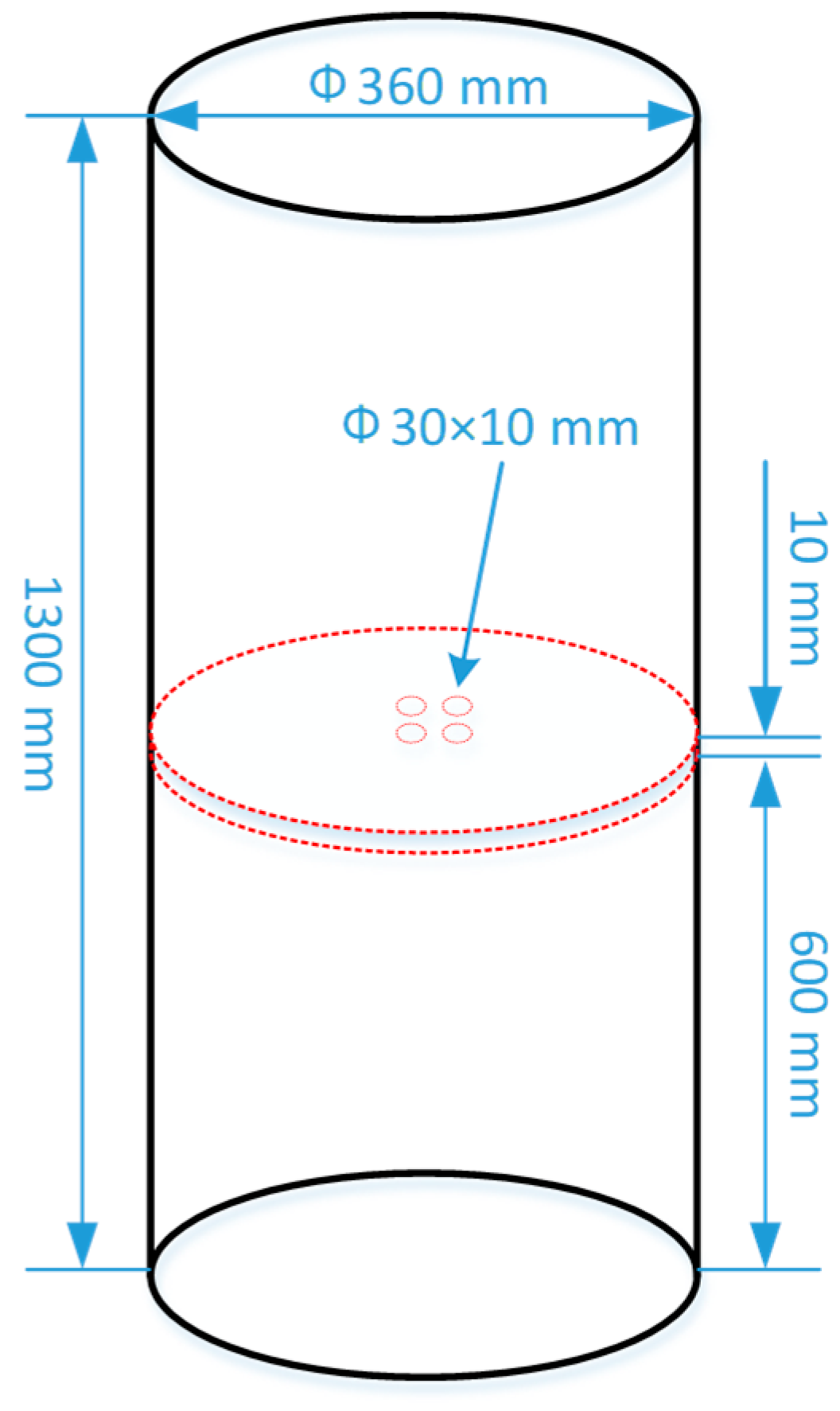
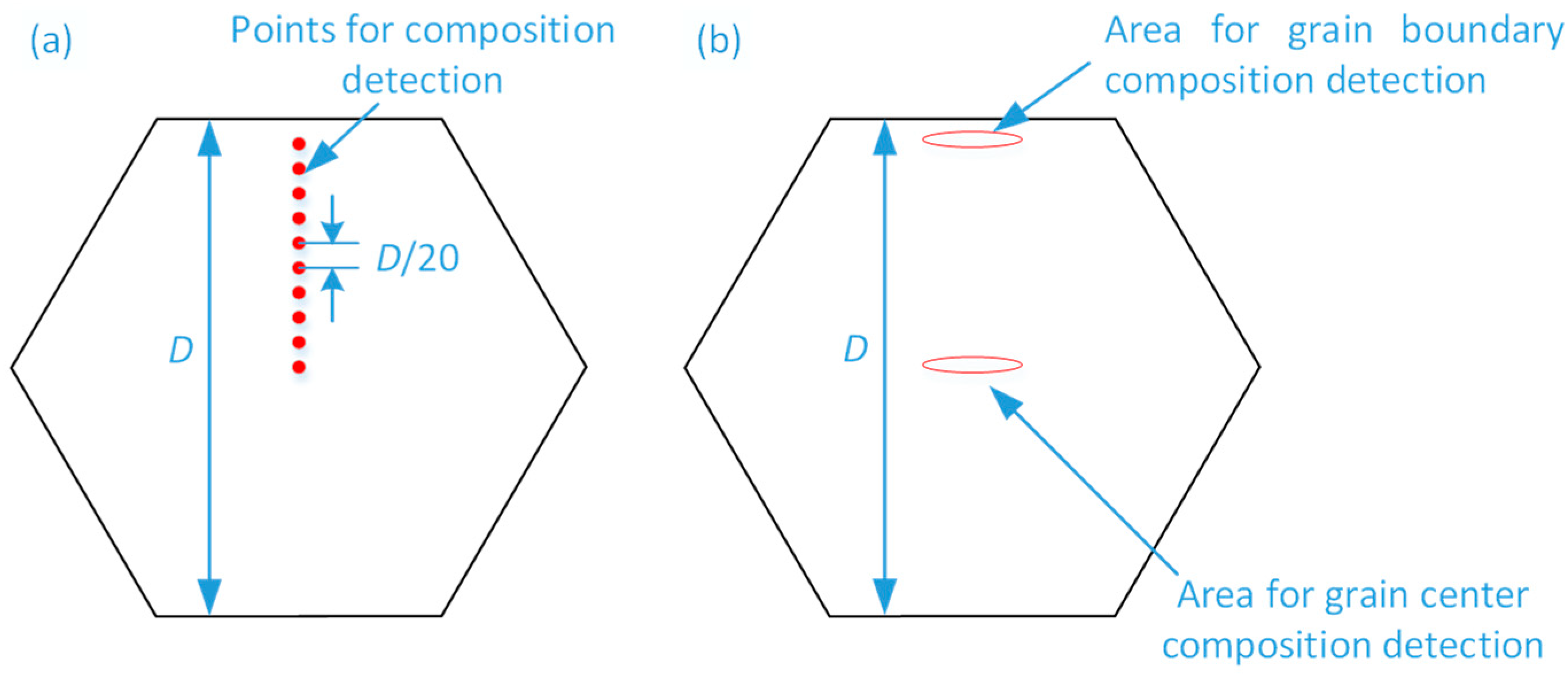

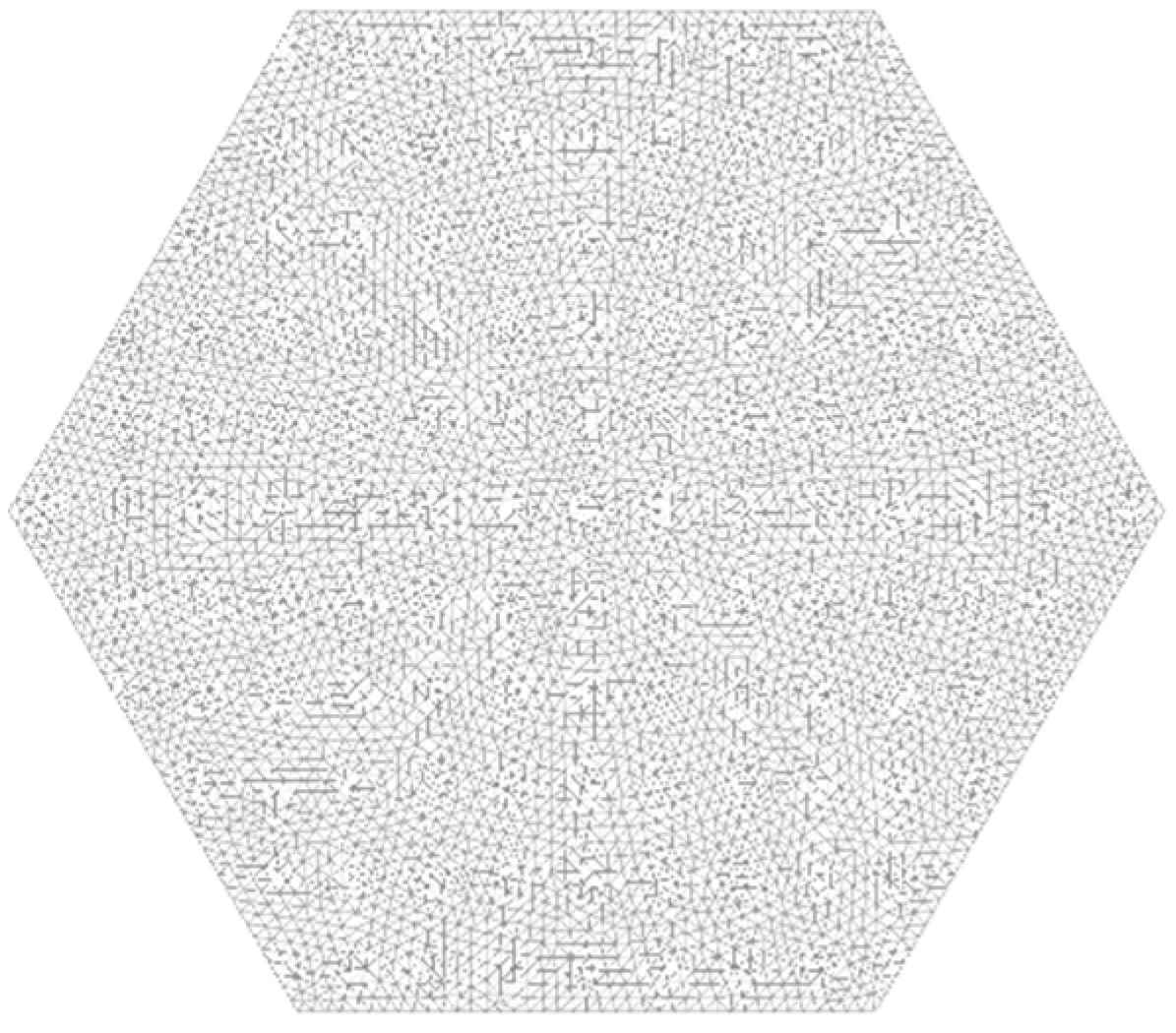
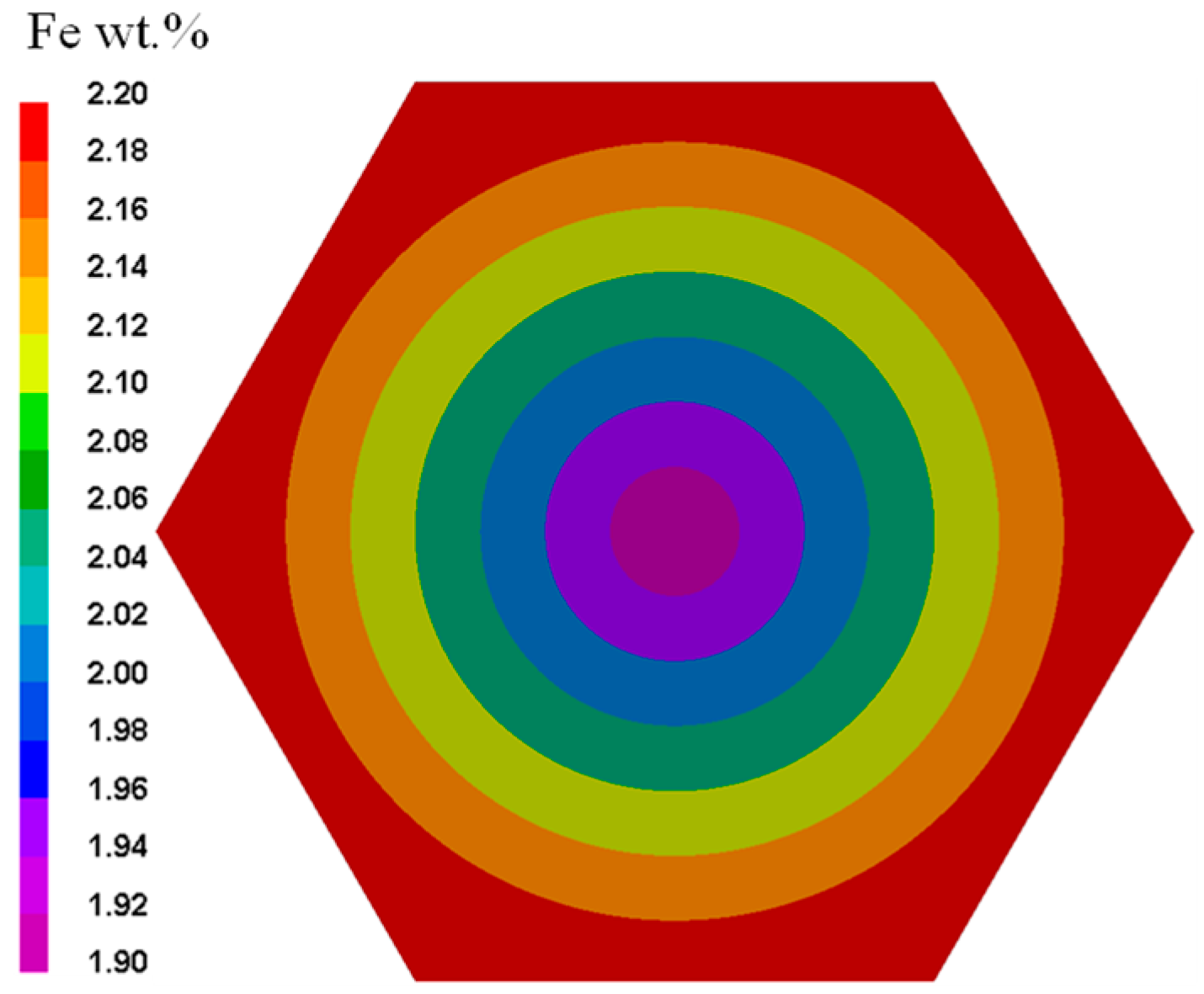
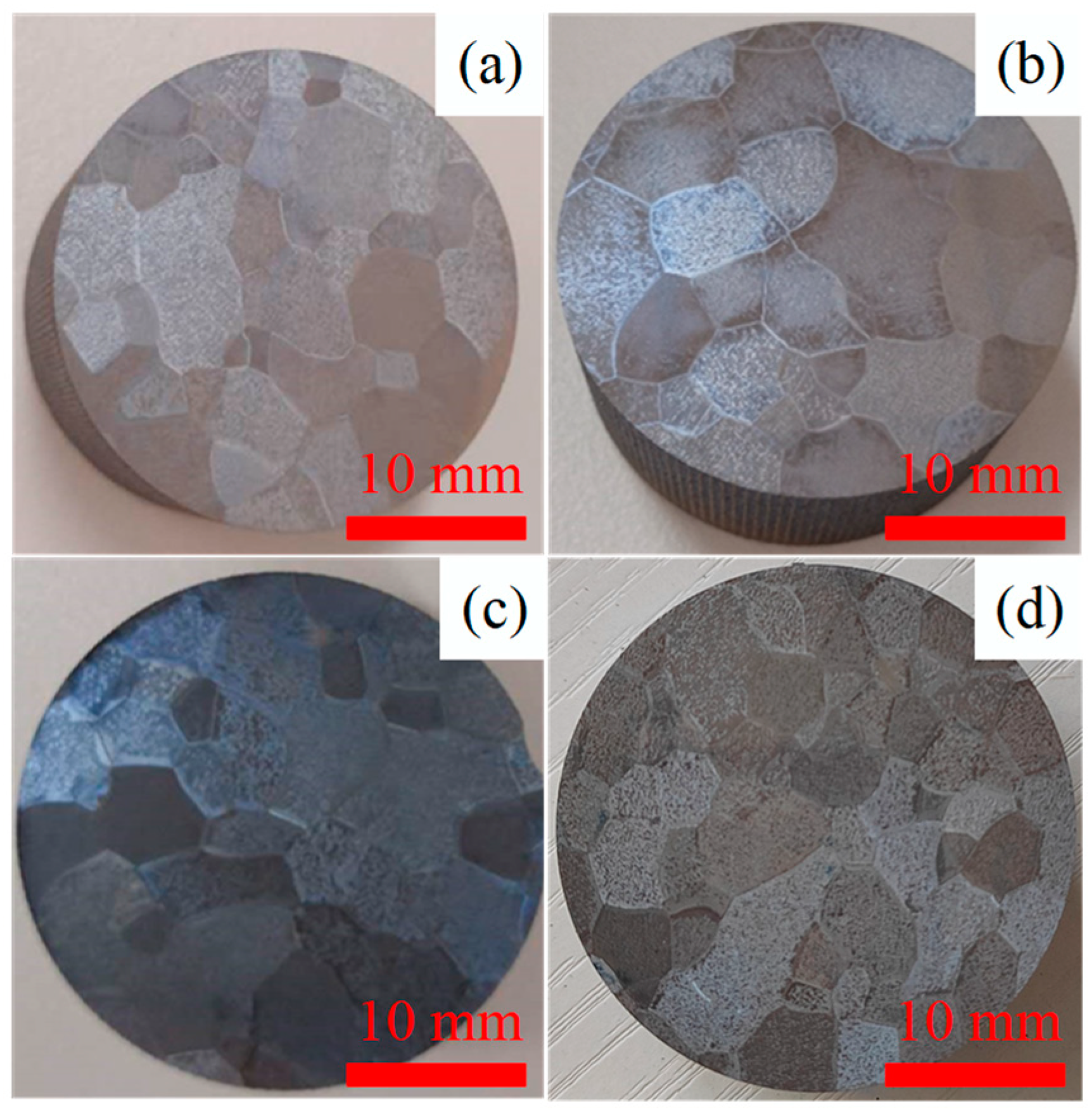
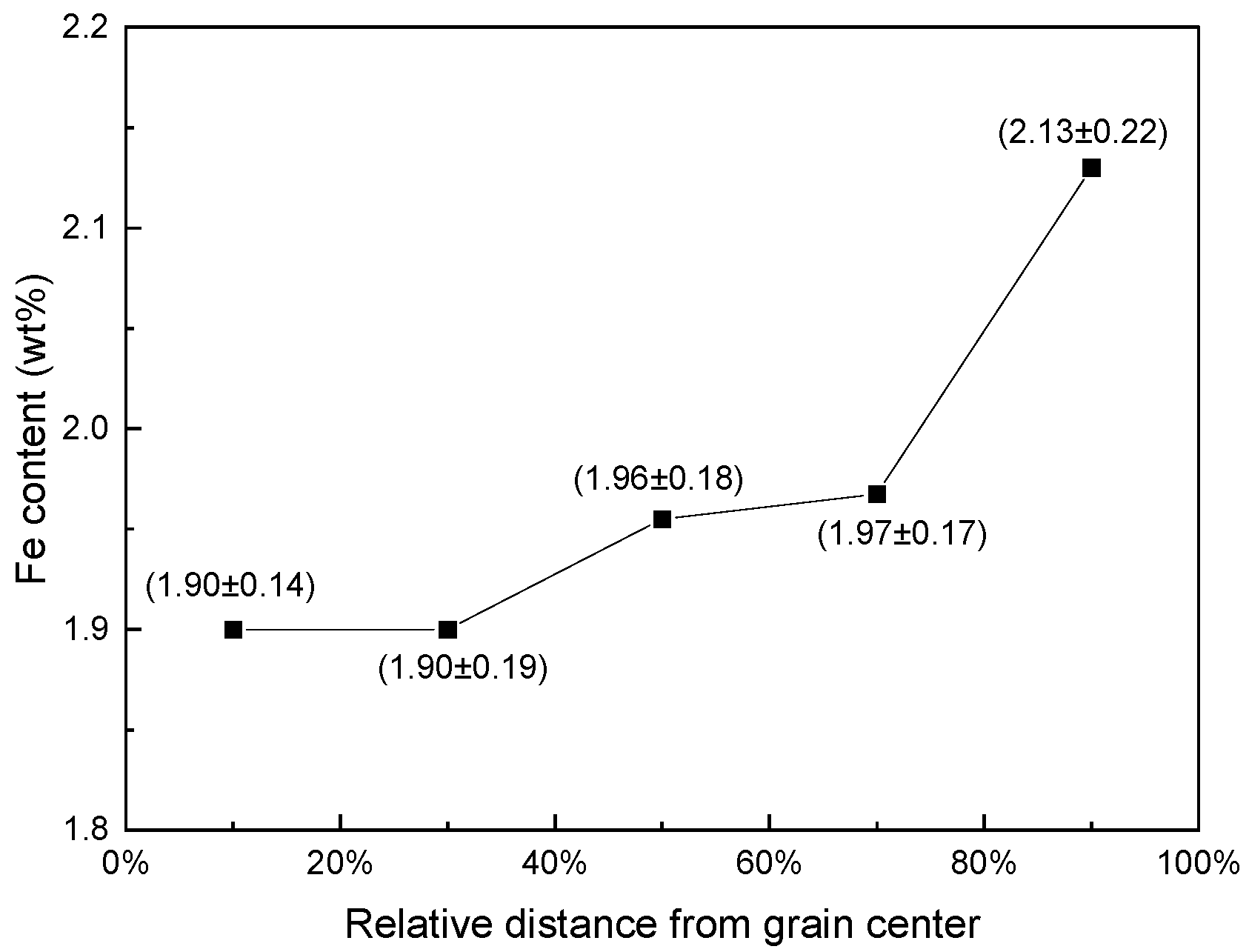
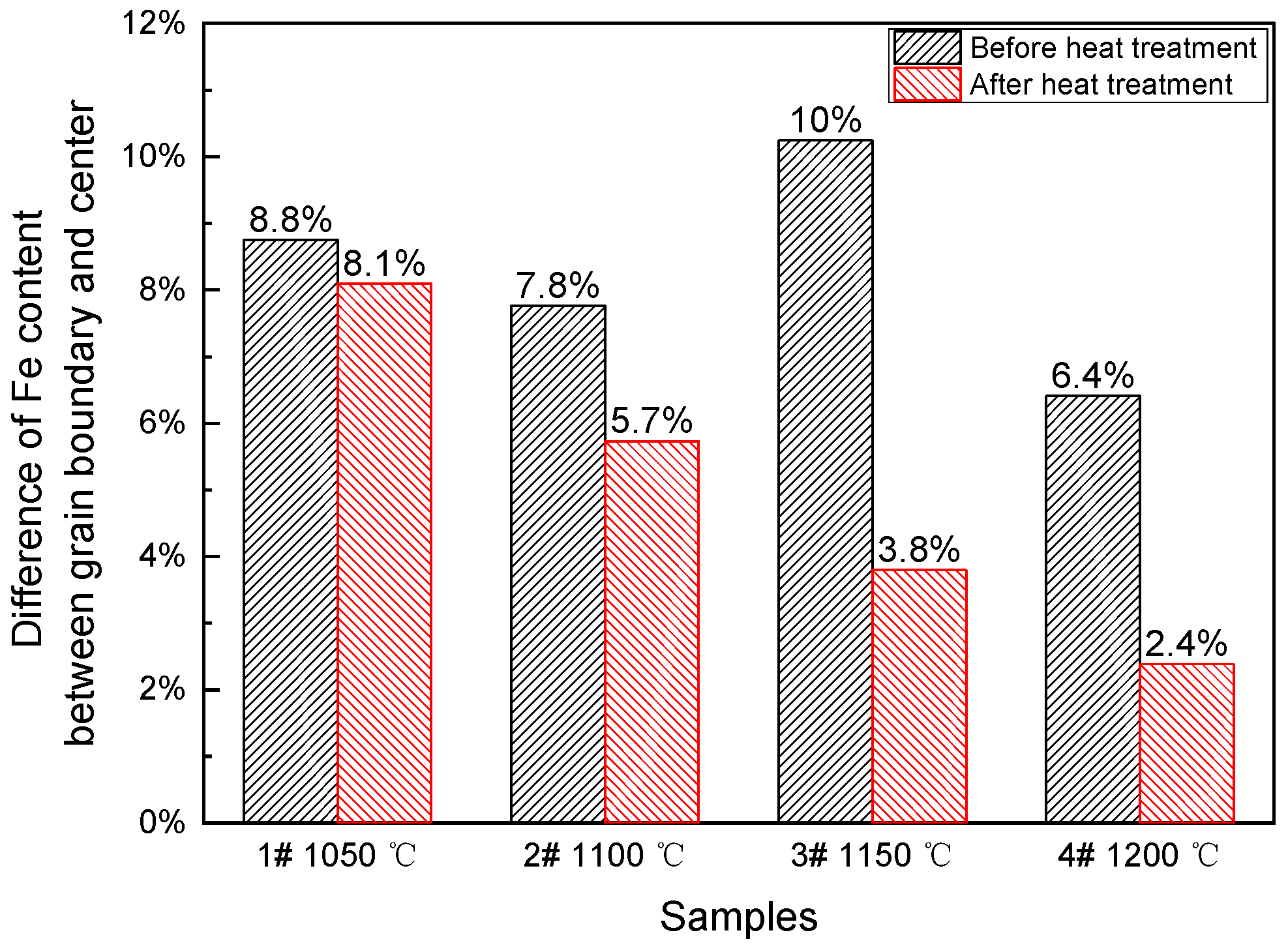



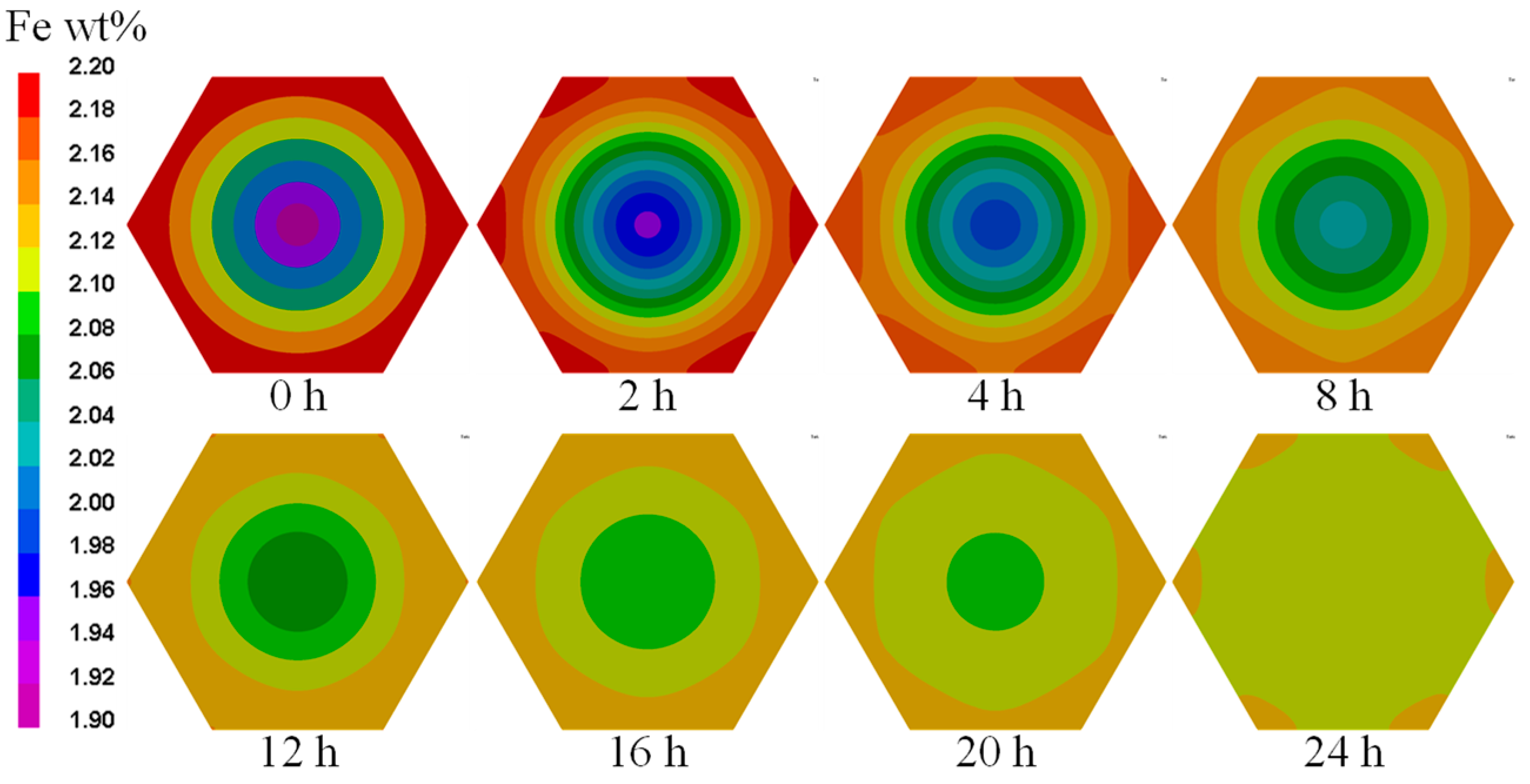
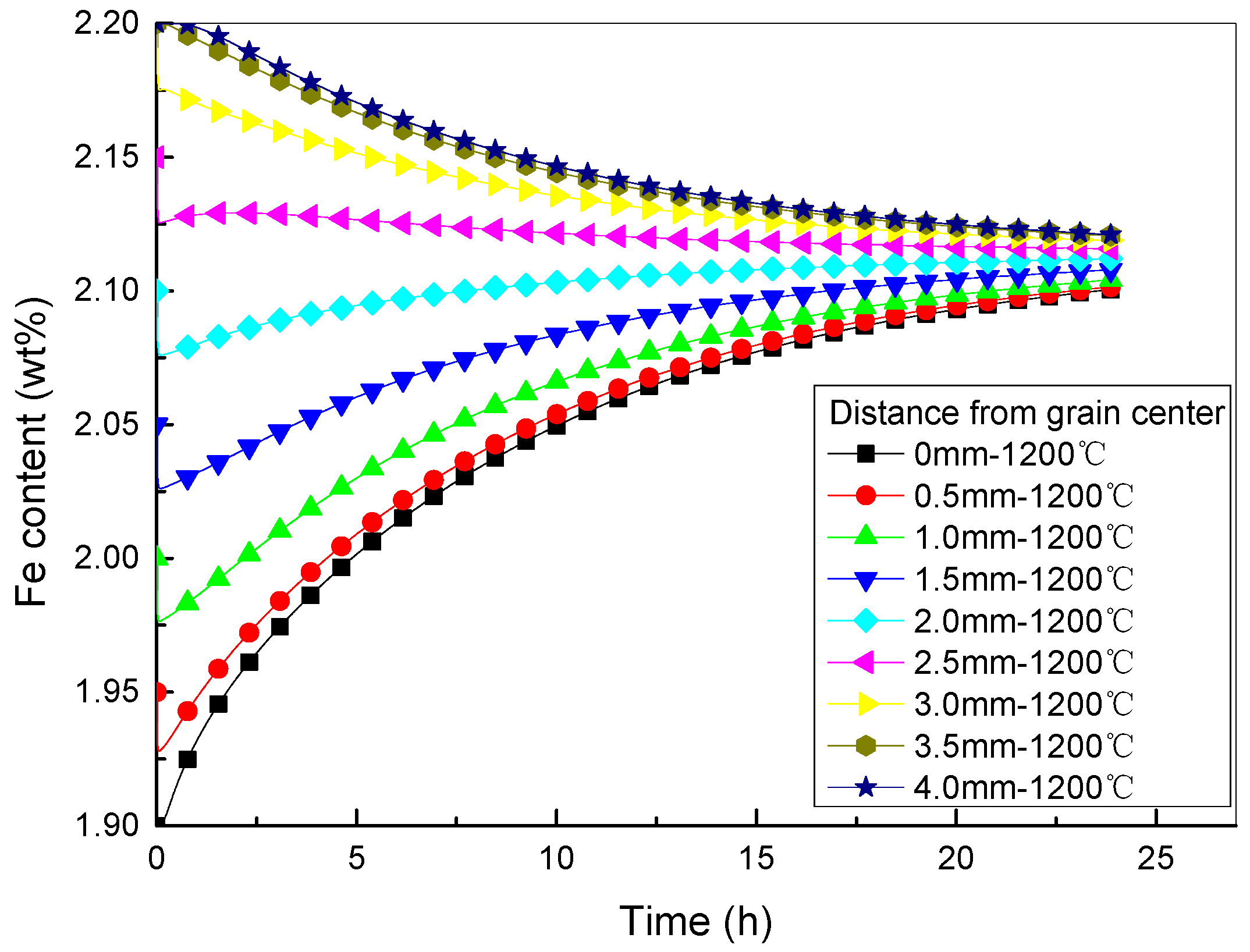
| Element | Al | V | Fe | O | N | H | Ti |
|---|---|---|---|---|---|---|---|
| Content | 3.02 ± 0.03 | 10.25 ± 0.05 | 1.92 ± 0.10 | 0.08 ± 0.01 | 0.009 ± 0.001 | 0.0012 ± 0.0003 | Bal. |
| Relative Distance from Grain Center | Sample1#-Grain1# | Sample1#-Grain2# | Sample2#-Grain1# | Sample2#-Grain2# | Sample3#-Grain1# | Sample3#-Grain2# | Sample4#-Grain1# | Sample4#-Grain2# |
|---|---|---|---|---|---|---|---|---|
| 0% | 1.81 | 2.15 | 1.95 | 1.69 | 1.93 | 1.92 | 2.20 | 2.10 |
| 10% | 2.04 | 1.94 | 2.15 | 1.78 | 1.67 | 2.02 | 1.80 | 1.80 |
| 20% | 1.97 | 1.91 | 2.12 | 1.58 | 1.83 | 1.84 | 1.90 | 1.80 |
| 30% | 1.84 | 1.89 | 2.16 | 1.87 | 1.69 | 1.55 | 2.00 | 2.20 |
| 40% | 1.89 | 1.89 | 2.22 | 1.84 | 1.80 | 1.71 | 2.10 | 2.00 |
| 50% | 1.76 | 2.28 | 2.10 | 1.82 | 1.65 | 2.13 | 1.90 | 2.00 |
| 60% | 1.66 | 1.97 | 2.13 | 1.86 | 1.96 | 1.79 | 1.80 | 1.80 |
| 70% | 1.77 | 2.29 | 2.11 | 1.92 | 1.68 | 1.87 | 2.00 | 2.10 |
| 80% | 2.10 | 2.48 | 2.07 | 1.68 | 1.68 | 1.92 | 1.70 | 1.60 |
| 90% | 1.98 | 2.49 | 2.23 | 1.81 | 2.04 | 1.99 | 2.50 | 2.00 |
| 100% | 1.90 | 2.28 | 2.25 | 1.59 | 1.99 | 2.13 | 2.50 | 1.50 |
| Sample# | Before HT | After HT | HT Temperature, °C | ||||
|---|---|---|---|---|---|---|---|
| Grain Boundary | Grain Center | Difference | Grain Boundary | Grain Center | Difference | ||
| 1# | 2.16 | 1.96 | 9.3% | 2.10 | 1.98 | 5.7% | 1050 |
| 1# | 2.22 | 2.04 | 8.1% | 2.18 | 1.90 | 12.8% | 1050 |
| 1# | 2.36 | 2.15 | 8.9% | 2.14 | 2.02 | 5.6% | 1050 |
| 2# | 2.20 | 1.96 | 10.9% | 2.08 | 2.01 | 3.4% | 1100 |
| 2# | 2.17 | 2.01 | 7.4% | 2.40 | 2.29 | 4.6% | 1100 |
| 2# | 2.20 | 2.09 | 5.0% | 2.15 | 1.95 | 9.3% | 1100 |
| 3# | 2.12 | 2.01 | 5.2% | 2.27 | 2.21 | 2.6% | 1150 |
| 3# | 2.17 | 1.91 | 12.0% | 2.38 | 2.29 | 3.8% | 1150 |
| 3# | 2.25 | 1.95 | 13.3% | 2.20 | 2.09 | 5.0% | 1150 |
| 4# | 2.24 | 2.02 | 9.8% | 2.11 | 2.03 | 3.8% | 1200 |
| 4# | 2.38 | 2.29 | 3.8% | 2.14 | 2.07 | 3.3% | 1200 |
| 4# | 2.40 | 2.26 | 5.8% | 2.46 | 2.45 | 0.4% | 1200 |
Disclaimer/Publisher’s Note: The statements, opinions and data contained in all publications are solely those of the individual author(s) and contributor(s) and not of MDPI and/or the editor(s). MDPI and/or the editor(s) disclaim responsibility for any injury to people or property resulting from any ideas, methods, instructions or products referred to in the content. |
© 2023 by the authors. Licensee MDPI, Basel, Switzerland. This article is an open access article distributed under the terms and conditions of the Creative Commons Attribution (CC BY) license (https://creativecommons.org/licenses/by/4.0/).
Share and Cite
Tong, J.-B.; Zhang, C.-J.; Chen, J.-S.; Yan, M.-Q.; Xu, R.-L.; Huang, L.-J. Effects of Homogenization Heat Treatment on the Fe Micro-Segregation in Ti-1023 Titanium Alloy. Materials 2023, 16, 4911. https://doi.org/10.3390/ma16144911
Tong J-B, Zhang C-J, Chen J-S, Yan M-Q, Xu R-L, Huang L-J. Effects of Homogenization Heat Treatment on the Fe Micro-Segregation in Ti-1023 Titanium Alloy. Materials. 2023; 16(14):4911. https://doi.org/10.3390/ma16144911
Chicago/Turabian StyleTong, Jian-Bo, Chao-Jie Zhang, Jun-Shu Chen, Meng-Qi Yan, Rui-Lin Xu, and Li-Jun Huang. 2023. "Effects of Homogenization Heat Treatment on the Fe Micro-Segregation in Ti-1023 Titanium Alloy" Materials 16, no. 14: 4911. https://doi.org/10.3390/ma16144911





